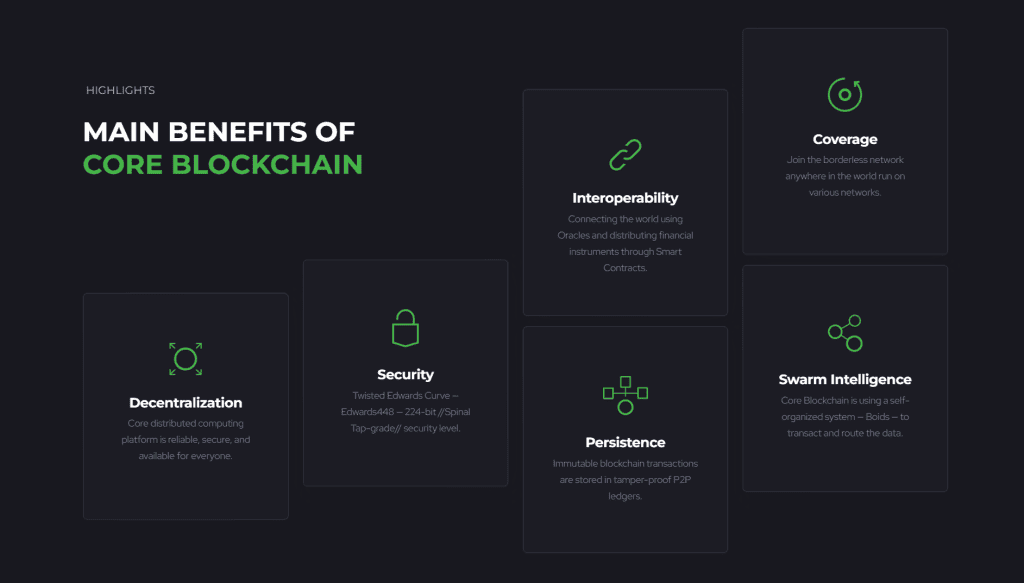Core (CORE) – Simplifying Crypto Self-custody
Blockchain Trillema is a common problem that most blockchain networks are facing these days. Every blockchain network aims to provide a high level of scalability, security, and decentralization. But unfortunately, they have to compromise on one of these aspects as they grow.
As a result, they can accommodate the needs of their users for long. Core is trying to resolve this problem with its hybrid consensus mechanism and a set of other important features.
Key Takeaways: –
- Core is a blockchain network that aims to provide a secure, scalable, and decentralized environment.
- Core is EVM-compatible, which means that developers can easily port their DApps and smart contracts to the Core network.
- Core offers a number of features that make it different from other blockchain networks, such as Satoshi Mining, DAO Governance, and Staking.
What is Core (CORE)?

Core is a blockchain network that is designed to provide a secure, scalable, and decentralized environment by combining the Proof-of-Work consensus mechanism with the delegated Proof-of-Stake consensus mechanism. Core is dedicated to providing a more equitable and democratic online environment.
Although the project is in its early stages, it has the potential to revolutionize the web3 with its innovative features.
Innovation – Core is dedicated to establishing a vibrant and innovative community of developers with its open-source nature. Anyone can contribute to the development of the project if they want.
Privacy – Unlike traditional platforms, Core protects users’ data with cryptography techniques.
Decentralization – The platform is resistant to censorship and fraud because it’s built on Web3 technology.
What Makes Core Different?

image source
Although Core shares most of its features with other blockchain networks, it offers some unusual features that aren’t available in other blockchains.
Core vs. Bitcoin – Core’s consensus mechanism is named after Bitcoin’s founder Satoshi Nakamoto because the project is primarily inspired by Bitcoin. However, it shares the scalability problem that users face with Bitcoin. Core can process far more transactions per second compared to Bitcoin.
Core vs. Ethereum – The Core’s development tools are very similar to those of Ethereum. Thus, developers can easily move their applications from Core to Ethereum. It also shares PoS concepts with Ethereum but it uses a modified version called DPoS. Thus, it enables more participants to help secure the network. And it ultimately prevents a group of users from taking control of the network.
Core vs. Polygon – Like Core, Polygon also offers a more scalable version of Ethereum with a set of sidechains. However, Core offers enhanced security compared to Polygon because it enables more users to contribute to the network’s security. On the other hand, Polygon’s validator set hasn’t changed since its testnet.
Core vs. Solana – Solana also provides a scalable environment with a Proof-of-History consensus mechanism and sharding techniques. But it also has some serious security setbacks. Similarly, the platform’s reputation is badly damaged due to block production halts and several notable chain restarts.
As discussed earlier, Core provides a more secure platform with its democratic nature. Moreover, it’s more affordable than Solana because Solana charges additional transaction fees for scalable performance.
Core Brief History
Core was introduced by a group of developers in January 2023. It was designed with the goal of providing a platform that can operate at the core of the web3. The platform incorporated the best parts of other blockchains like Bitcoin, Ethereum, Polygon, and Solana. The team also plans to adopt some features of Polkadot and Cosmos in the future.
Core Important Features
EVM Compatibility – Core is an EVM-compatible platform that enables developers to make their DApps and smart contracts accessible to a wide range of users while taking advantage of the speed, affordability, and flexibility of the Core.
Satoshi Plus Consensus – Core consumes less energy compared to the traditional PoW protocols because it combines the PoW consensus mechanism with DPoS. It provides a highly secure environment while preventing a single group of people from taking control of the project.
Satoshi Mining – Core offers an easily accessible form of mining called Satoshi Mining. The mining is named after the founder of Bitcoin because the project is inspired by Bitcoin. Even an average user can participate in the process by installing the Satoshi Mining App.
DAO Governance – Core’s DAO controls everything from transaction fees to governance parameters. They can submit proposals for the project’s development and vote on proposals submitted by other users. Currently, the Core team is overseeing the Core DAO but they have plans to transfer complete rights to the community members once a truly decentralized environment is formed.
Staking – As discussed earlier, Core uses the Delegated Proof-of-Stake consensus mechanism. Thus, it allows users to stake their CORE tokens to earn passive income. Similarly, the validators can scale their ability to mine new blocks by temporarily staking their CORE tokens.
How Does Core Work?
Core uses a Proof-of-Work consensus mechanism for validating transactions. The miners are required to all of their hash power to a preferred validator. Thus, it provides a secure and reliable ledger for transaction processing. Under the DPoS mechanism, every CORE token holder can participate in the validation process even if he doesn’t have a huge amount of tokens.
After creating a pool of validators from both systems, Core uses an algorithm to choose a blend of these validators. Thus, it offers optimal security and decentralization.
Core Tokenomics
CORE is the native token that powers the core network. With a circulating supply of 126.5 million tokens, CORE has a market cap of $101.8 million. It ranks among the 200 best cryptocurrencies in terms of market cap. It has a total supply of 2.1 billion tokens that will be released over time.
Conclusion
Core is a new blockchain network that aims to provide a secure, scalable, and decentralized environment. It offers a number of innovative features, such as Satoshi Mining, DAO Governance, and Staking. Core is still in its early stages, but it has the potential to revolutionize web3.
Feel free to get in touch with us if you need more information about how Core works. We also invite you to subscribe to our weekly newsletter if you need regular updates about Bitcoin and the crypto market.




